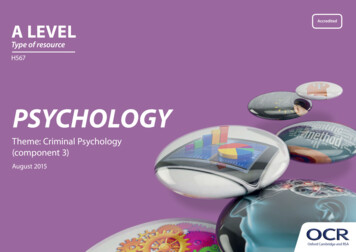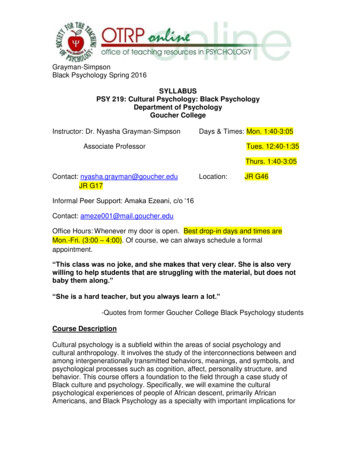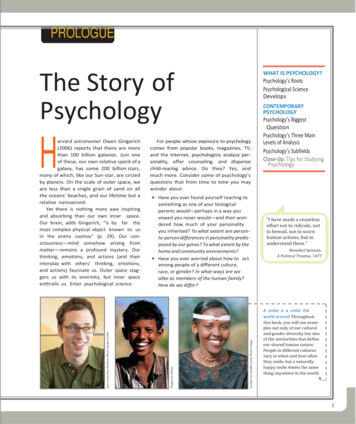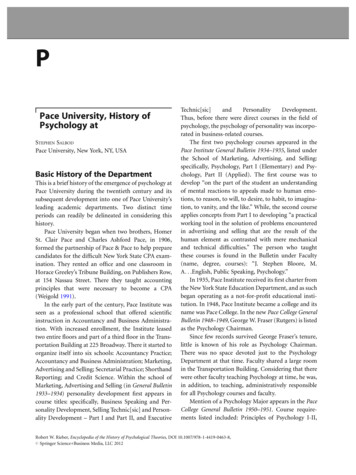
Transcription
Faculty for Children, Young People& their FamiliesCommunity Psychologyapproaches with children,young people and familiesWorking with whole communitieswww.bps.org.uk/dcp
Introduction‘In countries around the world, a shift of emphasis is needed towards preventingcommon mental disorders such as anxiety and depression by action on the socialdeterminants of health, as well as improving treatment of existing conditions.’World Health Organisation, 2014Further to this statement, the World Health Organisation focuses on: social cultural economic political, and environmental factorsThese include ‘national policies, social protection, standards of living, workingconditions and community support’ as some of the key issues which influencemental ill health.Community Psychology is increasingly being turnedto as a way of addressing these issues, and within thefield of clinical psychology, this approach is becomingincreasingly recognised and promoted.‘It is no measure of health to be well adjusted to a profoundly sick society.’Jiddu Krishnamurti2www.bps.org.uk/dcp
What is Community Psychology?Community Psychology is concerned with understanding people in theirsocial context and how wider structural and societal arrangements impact onpeople’s health and wellbeing. One useful definition of community psychologyproposed by experienced practitioners in the UK is:‘It is “community” psychology because it emphasises a level of analysis andintervention other than the individual and their immediate interpersonal context.It is community “psychology” because it is nevertheless concerned with howpeople feel, think, experience and act as they work together, resisting oppressionand struggling to create a better world.’Burton, Boyle, Harris, & Kagan, 2007At the heart of the approach is understanding how forces such as oppression,discrimination, exclusion, powerlessness and inequality impact on humanexperience. Community Psychology is therefore: value-led with social justice as a core value (e.g. Orford, 1992) action-orientated, often working in partnership with marginalised, vulnerableand disempowered people to create social change in social conditions asset-focused, meaning that services would look for resources at all levelsof a system which could both protect against possible negative outcomesand promote wellbeing focused towards preventative and community-led change.Figure 1: A change in perspective (Smail, 1999)SOCIAL stFamilySignificant othersSignificant otherswww.bps.org.uk/dcp3
Why is the focus shifting to CommunityPsychology?There are three key reasons for the current shift towards Community Psychology:1. Services need to consider the impact of social context and wider social forces,such as unemployment, inequality and low income, and be able to intervene atthese wider system levels to help prevent distress and not blame individuals2. Services benefit from being more accessible, appealing, asset-focused andnon-stigmatising. Community Psychology can help to reduce the barriers toengagement through community-led and co-production approaches.3. In an environment where mental health problems are increasing in linewith increasing inequality but funding for services is reducing, CommunityPsychology can help services become increasingly proactive, preventativeand financially stable.Case study: Better Beginnings, CanadaBetter Beginnings (Worton et al., 2014), aims to promote healthy childand family development in socially deprived communities. It is based onthe principles of being community-led, holistic, integrated and universallyavailable. Improved outcomes included fewer childhood behaviouralproblems, increased participation in the community, increased access tolocal services and increased neighbourhood satisfaction. Each step hasinvolved families within their communities and has shown to be a costeffective approach. It is now a highly recommended approach by UNESCO.Case study: Define Normal, UKSocial change can be effective at a small-scale and local level. For instance,psychologists in partnership with young people from an inpatient mentalhealth unit co-produced an experiential training exercise for mental healthprofessionals (Taggert, D. & Define Normal Project Team, 2011). Theproject was entitled ‘Define Normal’ and the team created a drama piecedemonstrating the experience of what being diagnosed with a mental healthproblem is like from the young people’s perspective. It allowed staff theytrained to gain a new perspective on the lived experience of feeling judged,stigmatised, confused and harmed by the mental health system.4www.bps.org.uk/dcp
The Department of Health Guidelines onCommunity EngagementThese guidelines outline the five elements of the Community EngagementModel, which focuses on the following requirements for a wholeserviceapproach: Grassroots and community work which co-define challenges andco-produce solutions. Community infrastructure, both statutory and non-statutory organisationsand residents, building connections across communities. Professional infrastructure which acknowledges the need for and value ofboth mainstream qualifications, and experience and local knowledge. Organisation development which focuses on leadership which can enablechange, and put in place the strategies and processes which enablemeaningful community engagement and influence the developmentof services. Effective co-ordination to ensure that community engagement is systematicand planned, and able to foster and interdependent and mutually interconnected strategic approach.For further recommendation about how to reach out to communities and bemore inclusive, see the NICE Guidelines for Community Engagement (2008).www.bps.org.uk/dcp5
How does Community Psychology change theway things are done?In order to achieve the kind of features noted above, there are shifts at everylevel of the way clinicians work:6 At the assessment and formulation stage, clinicians need to shift fromconsidering only the individual to look more broadly at the individual’sworld, and recognise the impact of their social environment. Community collaboration means that community members becomeco-producers of services and interventions, and the value of the uniqueand important knowledge of those with lived experience is recognised inshaping solutions. Collective interventions can be created together. Access to employment,welfare, community networks and secure housing are all crucial to thewellbeing of children and young people and hence Community Psychologyservices need to find ways of working with and through all of these areas tocreate effective interventions. Evaluations will embrace the subjective experience of clients,and focus onthe action research perspective mentioned above.www.bps.org.uk/dcp
!!!Figure1: Thetransitionfromfromtraditionaltraditional totocommunitypracticeFigure1: ThetransitioncommunitypracticeCase Study – MAC-UK, UKwww.bps.org.uk/dcp7
Case study – MAC-UK, UKThe ‘Integrate’ approach was developed by the charity MAC-UK inpartnership with excluded young people facing multiple challenges in thecommunity (Zlotowitz et al., 2016). The flexibility of the approach meansthat everything is an opportunity for young people to participate in andtry to create change for themselves and their community. To engage withthe young people, practitioners initially partnered with local communitygatekeepers and spent time in the community.The staff team includes experts by experience who can be graduates ofthe MAC-UK projects. The project works across levels. For example, at thepersonal level staff engage in ‘street therapy discussions around youngpeople’s use of cannabis for relief of depression. They support youngpeople to set up and lead interest groups for peers, and use motivationalinterviewing to discuss young people’s decision-making processes. At arelational level staff have supported young people to actively engage inyouth-led activities, worked with young people to improve communicationbetween their professional networks or have co-led training sessionsfor related organisations or professionals. At a collective level staff havesupported a young person to lead an action group for preventing theclosure of a local youth centre, have used guidance from young people tolobby government to improve statutory health provision for excluded youngpeople and have developed relationships with local health and wellbeingboards to improve health provision for young people.An evaluation of the above approach to engagingyoung people (e.g. those involved in gangs)who find conventional psychological services‘hard-to-reach’, found it had used specificprinciples that worked for young people, withproven psychological benefits (Zlotowitz et al.,2016). The Integrate approach is now widelyacclaimed at a national policy level within the UK,including within the recent CAMHS Taskforcereport (DoH, 2015).8www.bps.org.uk/dcp
Making the change to a Community PsychologyapproachIt can be hard to hold on to a community psychology approach in the currentenvironment of service and structural pressures and constraints, and someservices may find themselves continuing the same, traditional practices just ina different location. In order to avoid this, those wishing to follow a communityapproach might find it helpful to: Develop a network of enthusiastic and knowledgeable people who careabout the community. They can work directly in the community or connectwith the wider community online to share ideas. The British PsychologicalSociety Community Psychology section online platforms and networks arevaluable resources (www.communitypsychologyuk.ning.com). Involve local young people early on to keep the team focused and provideinfluence in the community. Working in this way engages communitiesand harnesses their capacity to solve problems and mobilise resourceswhich would not otherwise be available.It is a challenge, to work at multiple levels simultaneously and plan forprevention rather than react to need. Being proactive can be difficult whensystems are focused on individual work. Responses to this challenge mightinclude developing new structures promoting a community approach, such ascommunity mapping meetings, and designating a member of the team to takethe role of key worker for building community relationships, and modifyingexisting policies and IT systems.Many more ideas on making the changes to Community Psychology Servicescan be found in paper 6 of What good looks like in psychological services forchildren, young people and their families (see back cover for details).www.bps.org.uk/dcp9
Case study – Minding the Gap, UKA Borough in London has established a service partnership working group,where partners from all sectors have joined with young people to develop anddesign new services for children and young people across the transition ageof 16–25, to better meet the needs of the communities in which they resideand participate.Case study – The Kings Fund Leadership Programme, UKThe Kings Fund, a health and social care policy think-tank, has recentlylaunched a leadership programme which must be attended by a ‘clinicalleader’ and ‘patient leader’ from each service. Its aim is to teach thesepartners how they could meaningfully lead in a collaborative manner andto develop their skills to do so. Services who sign up to the programmeare therefore required to send a clinical/medical leader and a patientleader together. See aboratively-patients-and-communities for further details.10www.bps.org.uk/dcp
These are the features you should expect in aservice for children and young people whichtakes a Community Psychology approachThe service should: be driven by the values of social justice and transformational change usingevidence-based and practice-based research take a proactive approach in its design, delivery and evaluation, to addressthe multiple levels that impact on the health of children and young people,from the individual through the community to the wider, social context work with local communities and structures, particularly excluded groups,to define challenges and needs, and co-produce solutions empower practitioners and community members to create social changeand prevent distress and exclusion build alliances and networks to share learning and approaches work to have a positive impact on the most vulnerable and marginalisedyoung people in society.www.bps.org.uk/dcp11
This leaflet summarises a chapter in What good lookslike in psychological services for children, youngpeople and their families. More detail on the typesof help mentioned in this leaflet can be found in thechapter and also in the follow up publication What goodcould look like in integrated psychological services forchildren, young people and their families: Preliminaryguidance and examples of practice.Faculty for Children, Young People& their FamiliesThe Child & Family ClinicalPsychology ReviewNo 3 Summer 2015What good looks like inpsychological services forchildren, young peopleand their familiesHard copies (of the full volume or this leaflet) canbe requested for free from Helen Barnett, BritishPsychological Society: Helen.Barnett@bps.org.ukElectronic copiesThe full volume can be downloaded for free .htmlor by scanning the code below.If you would like to discuss any of the information in this leafletfurther, please contact: dcpchildlead@bps.org.ukwww.bps.org.uk/dcpISSN: 2052-0956
Community Psychology can help to reduce the barriers to engagement through community-led and co-production approaches. 3. In an environment where mental health problems are increasing in line with increasing inequality but funding for services is reducing, Community Psychology can help services become increasingly proactive, preventative and financially stable. Case study: Better Beginnings .










